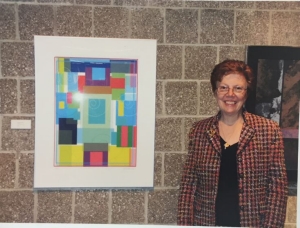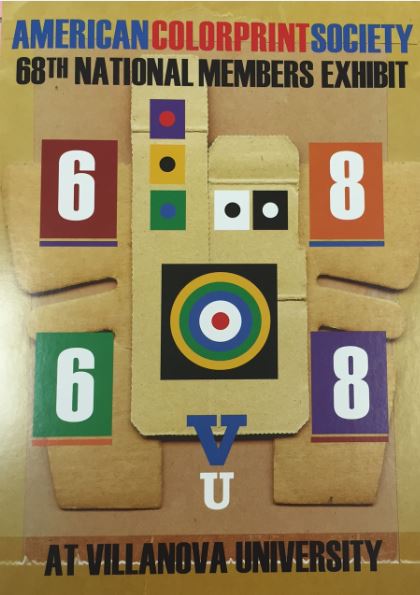American ColorPrint Society
(May 29-July 23, 2009)
68th National Members Exhibit

Maryanne Erwin smiles next to Print "Cubist 2" of Idaherma Williams
Members of American ColorPrint Society To Present Wide-Ranging Work in Villanova Exhibit
Villanova, PA –Though printmaking has been around for some thousands of years, it has been only within the past few hundred that it has come to be considered art over craft. And it’s only been within the last 69 years, when the Philadelphia-based American ColorPrint Society (ACPS) forced the issue, that work in color joined its black and white counterparts in United States print exhibitions.
Until 1940, juried print exhibits in the United States were limited to black and white work, typically etchings. Formed in 1939, the Society broke the color line the following year with the first juried show to welcome submissions in color.
Current ACPS President Idaherma Williams of Princeton, NJ, promises the Villanova show to be a vibrant exhibit presenting United States printmaking at its varied best – black and white work included and welcome. The exhibit is supported in part by the Pennsylvania Partners in the Arts, the regional arts funding partnership of the Pennsylvania Council on the Arts.
In opening printmaking to the use of color, the pioneering ACPS members who entered work in the landmark 1940 exhibit “encouraged experimentation, which today has become a part of our American art tradition,” the Journal of the Print World reported in its Fall 2006 issue. That experimentation “has extended to the materials and their combinations in printing: Oriental papers, rag papers, Arch papers, newspapers, even to printing on paper towels…,” the Journal noted.
The Society’s exhibit at Villanova covers a spectrum of printmaking media from lithography to digital prints. Artists working with knife, gouge, chisel, stylus, acids, computers, and other tools will offer original images printed from wood and linoleum to copper and zinc. Included will be work from reliefs, in which the print is created from inks, paints, dyes, and other agents adhering to the lines and engravings, etchings, aquatints, and collographs in which the ink is carried in the furrows created by the artist rather than the high-standing surface.
“As always, our members are working to make the Villanova exhibit as exciting as possible. Each of us is expected to turn out our very best work,” says ACPS President Williams. Having work judged by their peers is a requirement to gain membership in the Society and for inclusion in the schedule of juried exhibits that the ACPS has been presenting across the United States for the past 69 years. The emphasis is on presenting new work for each.
The emphasis on originality stems, in part, from printmaking’s long road in gaining status as art. By the Renaissance a few fine artists, notably the German painter, draftsman, and writer Albrecht Durer (1471-1528), developed printmaking techniques as a means of turning their drawing styles into graphics. But, as the work of transforming images into print was left mostly to technicians, printmaking continued to be viewed as a craft. Later, Rembrandt (1606-1669), noted for his etchings as well as his paintings, and Spain’s Francisco Goya (1746-1828), an etcher and lithographer as well as a foremost painter of his time and beyond, did much to usher in the modern era of printmaking as art.
By the 20th century, many European master painters were also printmakers, doing original work directly on stone and plate, as well as on their canvases. In the United States, however, printmaking and painting remained dichotomous, with printmakers focusing on technical achievement rather than original themes, images, and compositions.
By the latter half of the 20th century, that changed substantially, with printmaking rapidly evolving into a medium of original creative expression. More and more printmakers became painters and painters printmakers looking to one medium to inform the other and advance their work in both. Indeed, most American ColorPrint Society artists are both, including Idaherma Williams, though woodblock printing won her heart first, as a child: “I love every bit of the cutting, the tooling, the inking, and printing process. When you get the result that you want, you think you’re in heaven,” says the Society’s president.
The Society’s code of originality requires that each work accepted for a juried exhibit must pass creative muster on principles recommended by the Print Council of America. “(1) The artist alone has created the master image in or upon the plate, stone, woodblock, collograph material, or computer, for the purpose of creating the print. (2) The print is made from the original material, by the artist alone, or with a master printmaker. (3) The finished print is approved and signed by the artist.”
As printmaking faced its long road to becoming accepted as art, neither do printmakers lightly accept new printmaking media, the most recent example being computer-generated digital prints. After due consideration over a period of years, it was determined that “the creative process is the same [with digital prints] as with artists working with traditional printmaking methods.”
Selected works for the “68th National Members Exhibit of the American ColorPrint Society” may be previewed on the gallery’s website at www.artgallery.villanova.edu.


